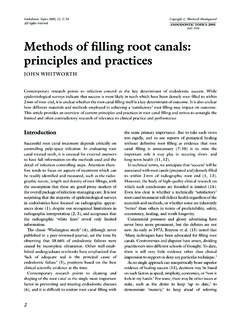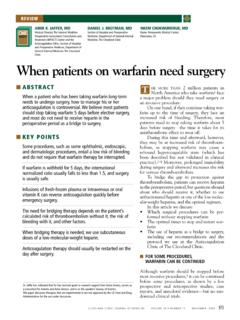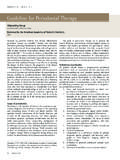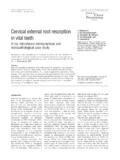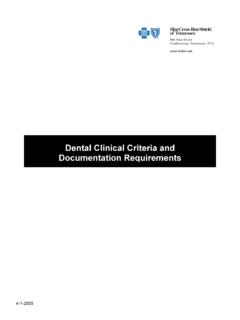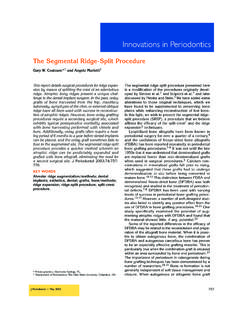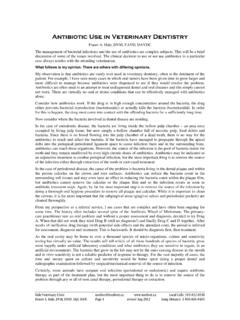Transcription of Diagnosis and treatment of accidental root …
1 Diagnosis and treatment ofaccidental root perforationsIGOR TSESIS & ZVI FUSSA review of endodontic and periodontal aspects on the prognosis, Diagnosis , prevention, and treatment ofaccidental root perforations is presented. Successful treatment depends mainly on proper Diagnosis and immediatesealing of the perforation to eliminate risk of infection. A classification of root perforations is presented in the reviewto assist the clinician in making a proper choice of treatment perforation is an artificial communication be-tween the root canal system to the supporting tissues ofteeth or to the oral cavity (1). Often, the cause isiatrogenic as a result of misaligned use of rotary bursduring endodontic access preparation and search forroot canal orifices (2 4).
2 accidental root perforationmay also complicate the endodontic treatmentper se,for example, during efforts to negotiate calcified andcurved canals as well as following lateral extension ofthe canal preparation to a so-called strip- perforation (5). Inappropriate post space preparation for perma-nent restoration of endodontically treated teeth is yetanother common iatrogenic cause of root perforation (3). Non-iatrogenic causes, including root resorptionand caries (4, 6 9), will not be addressed in this root perforations, which may have seriousimplications, occur in approximately 2 12% of endo-dontically treated teeth (4, 10 14). Bacterial infectionemanating either from the root canal or the period-ontal tissues, or both, prevents healing and bringsabout inflammatory sequels where exposure of thesupporting tissues is inflicted.
3 Thus, painful conditions,suppurations resulting in tender teeth, abscesses, andfistulae including bone resorptive processes may of gingival epithelium to the perfora-tion site can emerge, especially when accidentalperforations occur in the crestal area by lateralperforation or perforation in furcations of two- andmulti-rooted an infectious process has established itself at theperforation site, prognosis for treatment is precariousand the complication may prompt extraction of theaffected tooth (10, 15). Yet, if discovered early andproperly managed, prolonged survival of the tooth ispossible. This review relates specifically to the diagnosisand the impact of various factors on the prognosis, aswell as the principles for treatment of root also discusses measures for of significance to prognosisfor treatmentWhether or not a root perforation can be successfullytreated depends on whether the perforation can berepaired such that bacterial infection of the perforationsite can either be prevented or eliminated (16).
4 Anumber of factors including time from the perforationto detection, size, and shape of the perforation as wellas its location impact the potentials to control infectionat the perforation , numerous experimental studies have demon-strated that time is a most critical factor determiningoutcome of treatment , with immediate closure carry-ing the best prognosis. Lantz & Persson (17 19)produced root perforations in dogs that were treatedeither immediately or after some delay. The most95 Endodontic Topics 2006, 13,95 107 All rights reservedCopyrightrBlackwell MunksgaardENDODONTIC TOPICS 20061601-1538favorable healing response was evidenced when per-forations were sealed immediately. Seltzer et al. (20)treated 22 perforations in monkeys at intervals fromimmediately to 10 months post- perforation .
5 While theperiodontium was damaged in all teeth, the most severetissue destruction was in the untreated perforations andin teeth where treatment was delayed. Beavers et al.(16) observed consistent periodontal healing followingtreatment of experimentally produced root perfora-tions in a monkey model. The high success rate wasattributed to the immediate obturation of the perfora-tions and the aseptic technique used. Others support-ing these results found that delay in repair ofperforations decreased the prognosis for healing (21,22). However, Benenati et al. (23) observed that adelay in repairing perforations with amalgam did notinfluence the prognosis, if the perforation site had beenkept aseptic in the time interval from its , to minimize the potential for emer-gence of infection of the perforation site, these studiesinfer that the best time to repair root perforations isimmediately after occurrence.
6 Proper treatment of theperforation may not always be possible, due to lack oftime, lack of experience of the operator, and properequipment. The perforation is then best maintained byan adequate, bacterially tight temporary seal, and referralto a specialist for as rapid a treatment as perforations may not respond to repair aswell as smaller ones (24). Himel et al. (25) evaluated theeffect of three materials on healing of perforations of thepulp chamber floor of mandibular molars in dogs, andfound that the larger teeth with proportionally smallerperforations showed a better healing response. Largeperforations are more likely to occur during operativeprocedures, whenaggressivebursare used, causing moretraumatic injuries to the surrounding tissues.
7 Further-more, large perforations can cause the problem of anincomplete seal of the defect, thus allowing continuousbacterial irritation of the perforation area (26). Smallperforations clearly are easier to repair and thereforeprovide potential for predictable most important parameter affecting treatmentprognosis is the location along the root surface. Aperforation occurring relatively close to the crestal boneand the epithelial attachment is critical as it may lead tobacterial contamination from the oral environment alongthe gingival sulcus. Furthermore, apical migration of theepithelium to the perforation site can be expected,creating a periodontal defect (3, 17 20, 26 30). Oncethe periodontal pocket is formed, persistent inflammationof the perforation site is most likely maintained bycontinuous ingress of irritants from the pocket (26, 27).
8 These perforations have a poor treatment prognosis froma periodontal aspect, and treatment from the inside of theroot canal, even if adequately performed, cannot normallyimprove the of the furcation areas of multi-rootedteeth are similarly critical (3, 7, 17 19, 27, 31, 32) ( ). At times, they are especially troublesome as theinflammatory process may cause rapid and extensivedestruction of the periodontal tissues that ultimatelyleads to a permanent communication with the oralcavity and a persistently suppurating lesion (20, 24).Nevertheless, a high healing rate was attained in thetreatment of experimental furcation perforations inmonkeys (16). In 24 teeth of two monkeys, furcationperforations were sealed with either hard-settingcalcium hydroxide or Teflon disks.
9 All procedures wereperformed under strict aseptic conditions after ex-tirpating the pulps, and the access cavities were sealedwith hand-mixed zinc oxide eugenol cement andamalgam. Furcation perforations showed evidence ofhistologic healing after various time periods with noepithelial migration to the wound site (Fig. 1B,C). Anadditional set of lateral perforations exhibited similarevidence of periodontal tissue healing following treat-ment. According to the graphic illustrations given, thefurcation perforations were produced in the middle ofthe pulpal floor and directly into the crestal bone. Thefact that the epithelial attachment was not compro-mised may explain the high success rate, as well as thestrict asepsis and the atraumatic preparation of theexperimental perforations.
10 The long-term healingresponse was not studied in this & England (30) had a high clinical successrate following repair of furcation perforations inmonkeys using freeze-dried bone. However, histologi-cally, a layer of epithelium was found immediatelybeneath the perforation with no bone healing in any ofthe samples. From the radiographs presented in thestudy, the perforation defects were located at the crestalbone level and thus susceptible to epithelial & Fuss96 Perforations, coronal to the crestal bone, are easy toaccess and seal, and teeth may be restored withoutperiodontal involvement. For a good prognosis, thereshould be sufficient sound tooth structure for anadequate , apical to the crestal bone and epithelialattachment, are considered to have a good treatmentprognosis when adequate endodontic treatment isrendered and the main canal is accessible.
